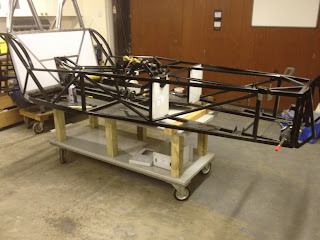Exiting times! We finally picked our gearbox up from GBS.
We opted to get the MT75 gearbox for few reasons over the type 9.
Before we bought we did our research to see the differences and pros and cons of the different gearboxes available for our build. The two main competitors were the Type 9 and MT75.
We picked the MT75 because it was "More reliable" as it comes from a Ford transit.
Lighter, weighing 7kg less than the type 9.
More torque, not that you'd need it from a 2 litre zetec but its nice to know it'l handle 300nm
And a synchronised reverse gear, for those times you want to impress the ladies with your J turn skills
One thing that the Type 9 does have over the MT75 is the fact that the innards can be changed with much more ease. This is good for people changing cogs over for different ratios on tracks. Seen as though the car would spend more time being cleaned than on a track this factor didn't really effect our decision.
 The refurbished unit looked ace! finished off with a black spray paint, looked like it had just come from the factory. Paint was scraped off the flat edges ready for gasket fitting. Two things that we did have to find out were what the two holes in the box where for. The circular one at the front and the rectangular one in the middle. Turns out the circular one is for a taxi meter, for all the lotus 7 taxis that are running about. The square hole is for the reversing light. Our gearbox came with a plastic cover with two wires which we are hoping connect up to the loom.
The refurbished unit looked ace! finished off with a black spray paint, looked like it had just come from the factory. Paint was scraped off the flat edges ready for gasket fitting. Two things that we did have to find out were what the two holes in the box where for. The circular one at the front and the rectangular one in the middle. Turns out the circular one is for a taxi meter, for all the lotus 7 taxis that are running about. The square hole is for the reversing light. Our gearbox came with a plastic cover with two wires which we are hoping connect up to the loom. 
















